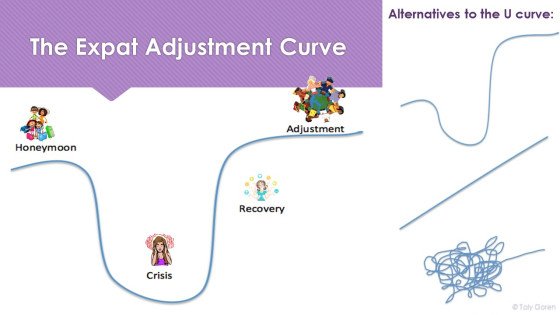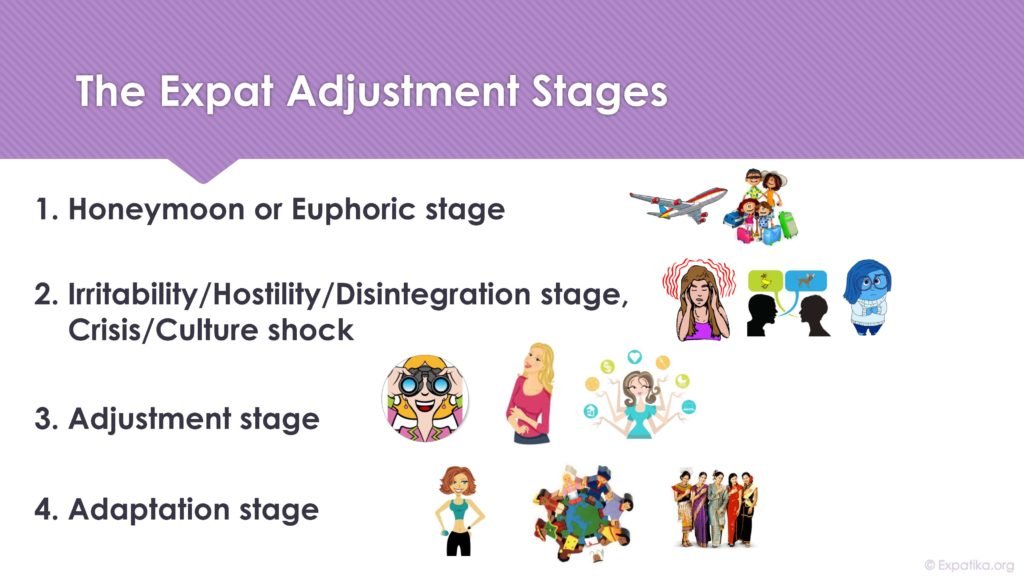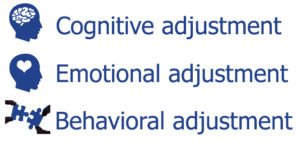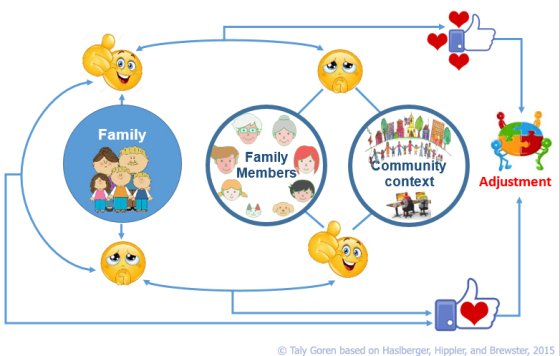An introduction to commonly used and less familiar models of adjustment
The process of adjustment, and in particular the relocation adjustment is commonly described using four key phases:
- The Honeymoon / Euphoria phase:
This phase includes the period immediately before and after the transition. At this time, the experience is new and exciting. Energy and enthusiasm are at their peak and the transition feels like a long and exciting trip.
- The Crisis / Cultural Shock phase:
At this stage feelings of dissatisfaction and hardship are starting to emerge as the initial excitement is replaced by a feeling of discomfort. This stage is characterized by communication difficulties, impatience, anger, sadness, and feelings of inadequacy and inability.
- The Adjustment phase:
Over this stage feelings seem to become more stable. Things are starting to look familiar and better understood, sense of humor returns and together with it a sense of balance in life.
- The Adaptation phase:
This phase is characterized by an increased feeling of security and a better sense of belonging. A sense of recognition and connection to the local culture and society emerges and with it the beginning of adopting local customs and habits.
Classic literature describes the four phases of adjustment as a U-shaped Curve
However, the adjustment process varies from case to case. In cases where the process occurs for the second time, following an earlier experience, the honeymoon period may be shorte r, the crisis less deep, and the curve may get a configuration which reminds more of the letter J. In other cases, such as an unexpected move or when relocation conditions are more complex, the honeymoon period may not happen and the adjustment will be characterized by a gradual linear increase. However, in most cases, the adjustment process is not a single-time occurrence and cannot be characterized by a single increase or decrease, and is better characterized by repetitive and parallel events creating different up and down simultaneous curves at different times and following different events. This situation was very well described by a blogger who painted the curve of adjustment as a complex tangle (U-Curve? Maybe not).
r, the crisis less deep, and the curve may get a configuration which reminds more of the letter J. In other cases, such as an unexpected move or when relocation conditions are more complex, the honeymoon period may not happen and the adjustment will be characterized by a gradual linear increase. However, in most cases, the adjustment process is not a single-time occurrence and cannot be characterized by a single increase or decrease, and is better characterized by repetitive and parallel events creating different up and down simultaneous curves at different times and following different events. This situation was very well described by a blogger who painted the curve of adjustment as a complex tangle (U-Curve? Maybe not).
What is considered as adjustment?
Adjustment may occur in three different levels. Cognitive adjustment – the level of knowledge and understanding of the new environment. Emotional adjustment – developing emotions towards the new place. And Behavioral adjustment – the use of adaptive behaviors towards the new environment.
Another diagram used to describe the family’s adjustment appears in an article by Haslberger, Hippler, and Brewster (2015). This diagram describes adjustment as a correspondence between family’s demands ![]() and capabilities
and capabilities ![]() .
.
In this model, demands and capabilities reside side by side in individual members of the family, in the family as a whole, and in the different elements surrounding it, hence the community context (school, the workplace, social networks).
The correspondence between demands and capabilities determines
the family’s satisfaction ![]() with itself as a whole, with its individual members, and with its community context, as well as the family’s “satisfactoriness”
with itself as a whole, with its individual members, and with its community context, as well as the family’s “satisfactoriness” ![]() – its ability to satisfy its members and its surrounding community. Adjustment in this model lies in the family’s ability to balance all these demands and capabilities.
– its ability to satisfy its members and its surrounding community. Adjustment in this model lies in the family’s ability to balance all these demands and capabilities.
Examples that will lead to good adjustment based on this model would be –
- A family which gathers as a strong and supportive unit to help a child adjust to his new school.
- A workplace that allocates resources to support the family during the first weeks of relocation.
- A spouse who is there to create social bonds with the surrounding community.
- And a community which in its turn provides the family with a supporting network while the working spouse is away on business trips.
How’s your family’s adjustment to the relocation? Share your stories in the comments below, and read my personal adjustment stories at Of Curves and Adjustments, What’s unique about those relocation adjustments?, and As we detach – getting ready to say goodbye.
For further reading, see the full articles “The U-Curve Adjustment Hypothesis Revisited: A Review and Theoretical Framework” by Black and Mendenhall in Journal of International Business Studies and “Another Look at Family Adjustment” by Haslberger, Hippler, and Brewster in Work and Family Interface in the International Career Context
By Dr Taly Goren, a long time traveler between nations and continents,
relocation specialist, parents groups facilitator, mother of two adolescent TCKs,
and the wife of a Hi-Tech Expat frequent flyer.




